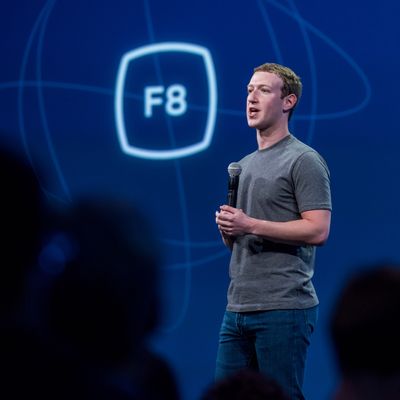
Like many adults of a certain age, I thought that AOL was the internet for some time.
I dialed up and onto the internet through AOL. I messaged my friends and answered email through AOL. I found things to look at on the internet on AOL’s boards. The breadth and depth of the World Wide Web manifested itself through that single service. And this week Facebook reconfirmed that it wants to be AOL: Its future is not just as a social network, but as a portal to anything and everything that you do online — these days, generally from a mobile device.
To that end, at its F8 developer conference, Facebook announced that it has beefed up its Messenger app. It is helping users add GIFs, videos, animations, and other multimedia options to Facebook conversations, making Messenger a better place to have the kinds of interactions users might currently have on Snapchat or Kik. It also announced a new service facilitating the dialogue between purchasers and retailers. If you buy a sweater online, say, and integrate that purchase with the Facebook app, you can see where the sweater is in the shipping process in real time or request the item in a new size.
That is not all. Facebook has also started a new initiative with news organizations, or what might better be thought of as “content businesses.” The change means that certain videos and stories might load faster in Facebook. And the company is now in talks with a number of publishers to optimize their work for the social network.
Facebook has also announced some upgrades that might help you manage your thermostat or garage door via Facebook. It will let you embed Facebook videos on other sites. And it will make it easier to carry out discussions on videos and other multimedia that appear on Facebook.
All of it might sound like small-bore stuff, unlikely to change your user experience in the Facebook site or the app. But all of these changes — and a number of other ones announced over the past year or two — are geared at making Facebook a nicer, faster, better-optimized place to be on the internet, and as such a better place to experience the internet as a whole. The idea is to make it so you are able to do more and might want to do more through Facebook, and thus do less elsewhere — watch a video, see a news story, share and comment on a piece of content, look at a photograph, chat with a retailer. As such, the goal is a distinctively 1990s one: to be a portal and a platform synonymous with the internet itself, like AOL.
The upshot for Facebook is obvious: more time spent within its ecosystem, thus generating more advertising dollars and higher advertising rates. The upshot for consumers is clear, too: a more entertaining, faster loading, more useful Facebook experience, all for free. The imminent threat is to other media businesses. By video hosting, for instance, Facebook is threatening YouTube. By amping up its Messenger function, its ad serving platform, and its search functions, it is threatening Google. And by partnering with a few media organizations, it is threatening all of the others — and threatening to leech the Facebook traffic that so many businesses rely on for their advertising dollars.
But by becoming AOL, might Facebook be consigning itself to that old internet giant’s fate? Might it become the jack of all internet trades and the master of none, easily replaceable by other, more elegant, more easily accessed services? Perhaps. But the site does not rely on subscription revenue the way AOL did; it relies on clicks. And it is not competing against the easily surfed open web, but against other apps in the higher-friction smartphone environment. Plus, the truth is that it is already a jack of all trades, and it seems to be working out, at least for now. Facebook is a less lovely photo-sharing service than Instagram, a less friendly public-update service than Twitter, a worse email platform than Google, a worse newsreader than any number of sites. But it is the best conglomerated service of all of them, given how bad Google has botched social. And it is trying to become less of a swamp and more of a garden.
Plus, its transformation into AOL has long since started. Many Facebook users, especially those overseas, think of Facebook as the internet, just like I thought of AOL as the internet. For them, Facebook getting better just means the web getting better.





























